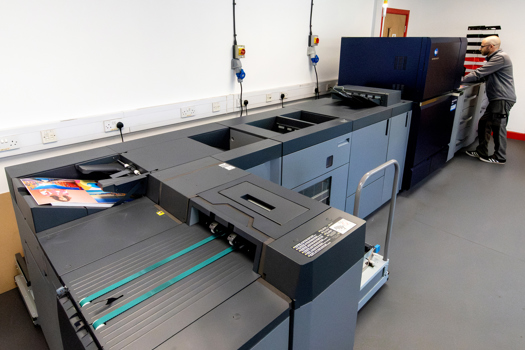It’s by far and away the most costly element of a print job, accounting for as much as 60% of the total, yet managing the amount of paper to be purchased and used remains one of the most difficult parts of a printer’s day-to-day role.
Sometimes the problem is self-inflicted, either by the printer or their customer. Take magazine printing, for example. One paper consultant, who prefers to remain nameless due to the sensitive nature of the subject, says that in the publishing industry at least 25% of paper bought is wasted. "The classic real width for printing an A4 magazine is 870mm," he says. "This allows for natural waste and trim but you’ll achieve something like 92%-93% utilisation of that paper, so you’re only going to waste about 8%. And yet there are publishers who will print A4 magazine on an 895mm sheet."
Most often, though, it is just the nature of modern printing. The rapid growth of on-demand print, which reduces printers’ ability to batch jobs, coupled with customers’ demanding ever-quicker turnarounds, means that printers have never found it as tough to anticipate how much paper they’re going to need and when they’re going to need it.
This whirlwind of factors is creating a logistical nightmare that shows little sign of abating, as most industry experts expect demand for on-demand print to grow significantly over the next few years, with lead times further reduced. So how best can printers adapt to this new environment and ensure that they have good paper management practices in place to eradicate inefficiencies and save themselves – and their customers – money in the process?
One radical approach is to limit the number of paper options offered to customers. This is the route that ESP Colour managing director Anthony Thirlby opted for. Thirlby says that he decided to "streamline the paper types we produce to ensure we retain as much continuity in manufacturing as possible". As a result of this streamlining process, ESP offers one choice of coated substrate and one choice of uncoated.
He argues that by adopting this approach the company is taking the hassle of choosing away from clients, who are more than happy for this choice to be taken out of their hands so long as the job is being produced as cost effectively as possible. He also claims that to some extent, he was forced to go down this route due to the dwindling options being offered up by paper mills and merchants.
"One of the main issues we encountered was around the supply of uncoated papers," says Thirlby. "The stock holding on these products seems to be very erratic, which is
why we have gone down to one range on this."
It’s an issue that he doesn’t expect to be resolved any day soon. "I believe limited supply will continue to be a possible headache moving forward with the mills’ reluctance to service the UK to the levels they have previously," adds Thirlby.
ESP’s radical approach to this problem has attracted a mixed reaction from the industry. Arjowiggins Graphic national key accounts manager Julian Long supports the printers’ stance. "This is a really smart move by Anthony and if it fits with your business it is something that I would advise," says Long. "This decision means that you have a better rationalisation on grammages and sheet sizes and just makes the whole process much easier to manage."
Others point out that, although this is great for ensuring that you have the paper stock available to print last minute jobs (and ensuring you don’t have any costly leftovers of expensive stock lying unused), it is not an approach that all print businesses would be able to adopt. Just as printing is becoming more on-demand, it is also being forced to become more innovative and flexible in order to maintain its place in the media mix. Flexibility means giving the customer what they want and for a large section of the print market – in particular the stationery markets – that choice is a varied one.
Obviously, no printer or merchant can ever hold every conceivable paper option. For special papers, you simply cannot offer the speed of turnaround of a more standard paper without having a massive warehouse full of paper varieties. But standard papers do still incorporate a wide range of options and clients that are often happy to select from a scaled-down selection.
Hence, managing a varied stock is a problem most printers are going to have to contend with. There are two ways to do this effectively according to the experts: with a paper management software system or by utilising the increasingly on-demand services of paper merchants.
Paper management software options are something that increasing numbers of printers are turning to. In October, magazine printer Stephens & George Print Group (S&G) added paper management to its Crimsonwing ERP system. S&G implemented barcoding throughout its warehouse so that every reel and sheet of paper could be tracked, with the company able to see where the stock is going and how much of it is being used. Many other MIS and ERP systems can perform a similar task – for a cost.
New breed
Paper buyers using this new breed of paper management systems are typically promised that they can reduce their annual paper usage by 5%-10%, with the greater transparency offered by this type of system promising further cost savings.
"When printers quote for a job, they estimate a makeready of so many copies and the running waste," says the paper consultant. "However, their method of calculating these figures is so unscientific that they might as well toss a coin. Paper management systems make it more
scientific."
Yet the paper suppliers and some printers argue that splashing the cash on expensive software is not necessary. Instead, building a strong relationship with the paper supplier and utilising the 24-hour service and next day delivery options most merchants now offer can be the most effective method of managing paper, according to Thirlby.
"We have a very good relationship with our main supplier EBB, which has positioned itself to serve the market we operate in," he explains.
With next-day delivery, or in some cases same-day delivery, dealing with on-demand jobs becomes simpler without the need for software – the on-demand nature of print has gone up the chain and you now have on-demand paper delivery to match. Robert Horne talks up its same-day delivery service and its technical support call centre as evidence of it changing to facilitate the new print reality. Arjowiggins is similarly in tune.
"Printers need to have merchants that have very good levels of stock and can deliver within a short notice period," says Arjowiggins’ Long. "If you need to get a specific paper for a job at short notice, it is no good if your merchant turns around and tells you that it is not going to be able to deliver it that day."
The downside of this approach, of course, is that merchants may not have the paper you want in stock. If you are relying on that relationship rather than what you have in stock yourself, and that merchant does not have the stock the client wants, you are in danger of losing out on that job. This takes us back to Thirlby’s earlier point that supply of a range of stock remains an issue.
Whether printers go for paper management software or closer relationships with suppliers is not always simple, then. For a printer dealing with a client base prone to a wide variety of substrate demands, it may be that buying a wide range of paper in advance and holding stock in preparation – using a paper management software system to do so efficiently – might be the best option. However, if a relationship with a merchant can be struck whereby that same variety can be delivered same-day, this may well be the best approach.
Likewise, for a model like ESP’s, a close relationship with the merchant is working for Thirlby, but a paper management software system may be just as effective for some companies that are operating a similar model.
It may be, then, that a combination of the two is the best solution. Having a close eye on paper usage via a paper management system can inform better buying and also facilitate that closer relationship with the merchant. You can help the merchant to service that demand by knowing what you will need most commonly, what you will need less commonly and rough ideas of usage levels.
It’s a complicated issue, admittedly, and it is one being made more complicated by the lack of open discussion on the issue. In the writing of this article, the reticence on the supplier and print side to discuss the issues – as evidenced by the plea for anonymity from some of those that did agree to be quoted and the very few that went on the record – shows that paper management remains a taboo issue. As long as it remains so, restricted debate is going to mean continued issues for printers and the problem being exacerbated through a lack of transparency on best practice and options.










